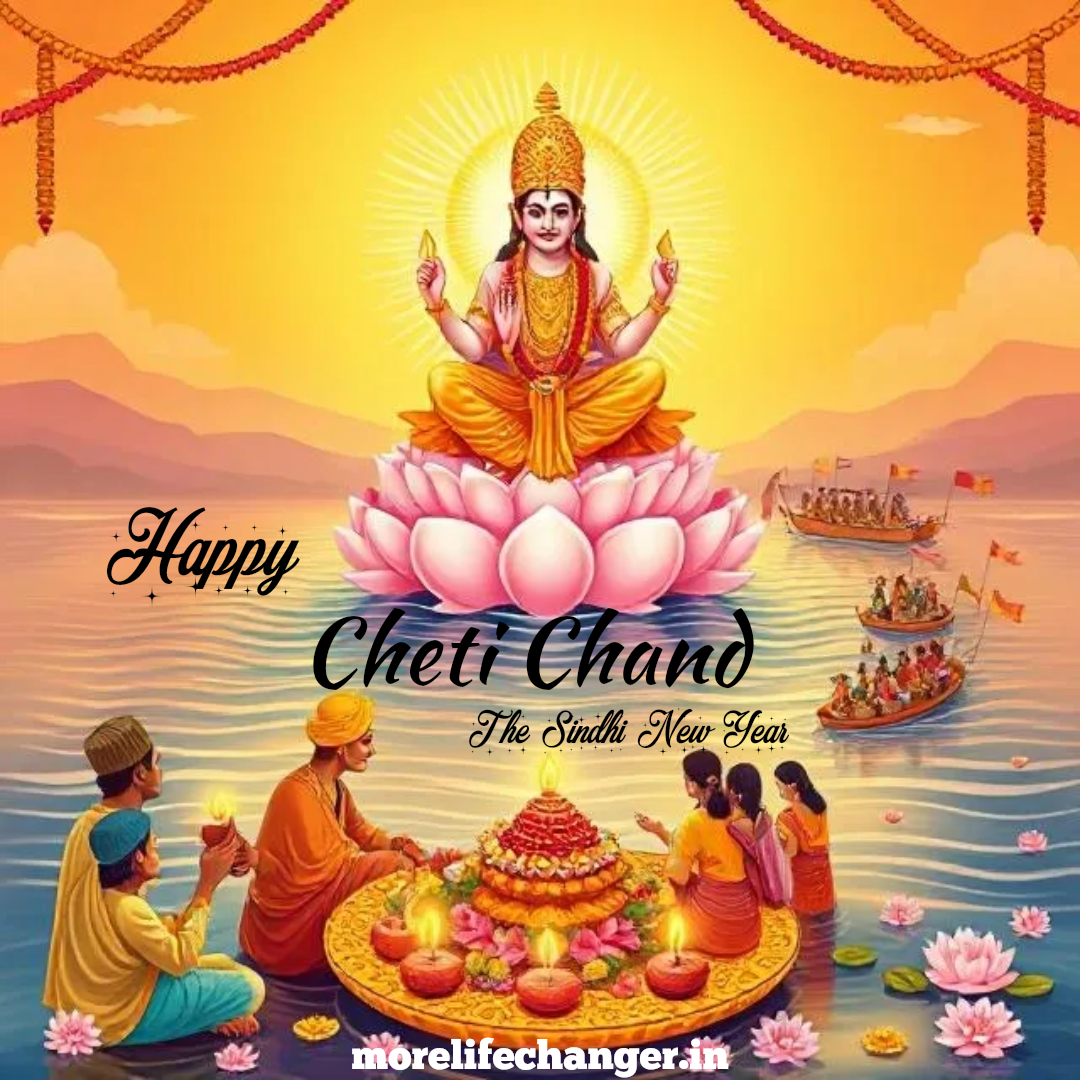Cheti Chand is the Sindhi New Year, celebrated to mark the birth anniversary of Jhulelal, the patron saint of Sindhi Hindus. It falls on Chaitra Shukla Dwitiya (the second day of the bright half of Chaitra month), usually a day after Gudi Padwa, Ugadi, and Navreh.
Significance of Cheti Chand
- Birthday of Jhulelal – Cheti Chand is dedicated to Jhulelal, the revered deity of Sindhi Hindus, believed to be an incarnation of Varuna Dev (the Water God).
- New Beginnings – It marks the start of a new year in the Sindhi calendar.
- Victory of Faith – It commemorates the Sindhi community’s survival and prosperity despite challenges.
Legends of Jhulelal
According to legend, during the 10th century, Sindhi Hindus faced religious persecution from a tyrannical ruler, Mirkh Shah, who wanted to forcefully convert them to Islam. They prayed to the River God (Varuna Dev), and after 40 days of fasting, Jhulelal was born as their savior. He performed miracles, convinced Mirkh Shah to allow religious freedom, and became the spiritual guide of Sindhis.
His name “Jhulelal” comes from the word “Jhule” (to swing) because he is often depicted as a child sitting on a fish that swings over water.
How Cheti Chand is Celebrated
1. Jhulelal Worship & Rituals
- Devotees perform “Behrana Sahib”, a special prayer offering to Jhulelal.
- A sacred thaal (plate) is prepared with wheat, sugar, coconut, flowers, and a lit diya (lamp).
- This is floated in a river or any water body, symbolizing gratitude to Varuna Dev (Water God).
2. Processions & Jhul-Jhulni (Swinging the Idol)
- Sindhi communities take out grand Jhulelal processions with music and dance.
- Devotees carry Jhulelal’s idol in a beautifully decorated palanquin and chant:
“Jhule Jhule Jhulelal, Bera Hee Paar!” (Jhulelal, help us sail through life’s journey!)
3. Fasting & Community Feasts
- Many Sindhis observe a fast (Vrat) till evening and then break it with a special meal.
- Traditional dishes include Tairi (sweet saffron rice), Sai Bhaji (spinach and lentil dish), Chana Dal, and Sindhi Kadhi.
4. Sindhi Folk Music & Dance
- Cheti Chand is filled with joy, marked by Sindhi folk songs, bhajans, and dances like Chej.
- Cultural programs are organized by Sindhi communities worldwide.
Also read : Lunar new year
Rituals & Traditions
Cheti Chand is a sacred festival for Sindhi Hindus, marking the birth anniversary of Jhulelal and the Sindhi New Year. The festival is celebrated with devotion, community gatherings, and vibrant cultural events.
1. Morning Rituals & Special Prayers
Jhulelal Puja & Behrana Sahib
The main ritual of Cheti Chand is the Behrana Sahib, a special prayer offering to Jhulelal. Families and community members gather to perform this sacred ritual.
Preparation of the Behrana Sahib Thaal:
- A plate (thaal) is arranged with:
- Wheat flour or sugar (symbolizing prosperity)
- A lit diya (oil lamp) (signifying divine light)
- Flowers (for devotion)
- Coconut (a sacred offering)
- Fruits & sweets (as prasad)
- Incense sticks (Agarbatti & Dhoop)
Process of Behrana Sahib Puja:
- A lamp (Jyot) is lit and placed in the thaal.
- Devotees chant Sindhi bhajans & Jhulelal prayers.
- The thaal is later floated in a river, pond, or water body, symbolizing gratitude to Varuna Dev (the Water God) and Jhulelal.
Significance: This ritual represents the Sindhi people’s deep connection with water, as Sindh was historically a land of traders and river-based civilization.
2. Processions & Jhul-Jhulni Tradition
- Grand processions (Rath Yatra) are taken out in many places.
- The idol or picture of Jhulelal is carried on a decorated palanquin and placed on a swing (Jhula).
- Devotees chant “Jhule Jhule Jhulelal, Bera Hee Paar!”, meaning “O Jhulelal, help us sail through life’s journey.”
- The procession is accompanied by Sindhi folk music, drums, and dance performances.
In Sindh (Pakistan) and other Sindhi communities worldwide, this tradition is followed with great enthusiasm.
3. Fasting & Breaking the Fast
Many devotees observe a fast (Vrat) from sunrise to evening in honor of Jhulelal.
Rules of the Fast:
- Devotees consume only fruits, milk, and water throughout the day.
- The fast is broken after performing the evening Behrana Sahib puja.
Sindhi Traditional Food for Cheti Chand:
After the fast, a grand meal is prepared, including:
Tairi – A sweet saffron-flavored rice dish with dry fruits.
Sai Bhaji – A nutritious Sindhi dish made with spinach, lentils, and vegetables.
Sindhi Kadhi – A tangy gram flour-based curry with vegetables.
Chana Dal & Puri – A festive meal combination.
Sindhis share food with neighbors, friends, and the needy as a part of their tradition.
4. Sindhi Bhajans & Cultural Events
- Sindhi community halls and temples organize bhajan-kirtan (devotional singing) sessions.
- Popular Jhulelal bhajans and Sindhi folk songs are sung in praise of the deity.
- In many places, Cheti Chand Melas (fairs) are held, featuring dance performances like Chej, traditional Sindhi plays, and Sindhi food stalls.
5. Sindhi Charity & Community Service
- Cheti Chand emphasizes Seva (selfless service), and many Sindhis perform charity and donations.
- Free food distribution (Langars) are organized at temples and community centers.
- Donations to needy families, orphanages, and religious institutions are common.
6. Visiting Sindhi Temples & Shrines
- Devotees visit Jhulelal Temples and Sindhi Dharamshalas to seek blessings.
- In Pakistan, Sindhi Hindus gather at Jhulelal shrines near the Indus River.
- In India, famous Jhulelal temples in Mumbai, Ulhasnagar, Ajmer, and Hyderabad are key pilgrimage sites.
Global Celebrations
Cheti Chand is celebrated by Sindhi communities across India (Mumbai, Pune, Rajasthan, Gujarat, Madhya Pradesh) and around the world in Pakistan, Dubai, the USA, the UK, and Canada.
Please join discussion on Facebook about world facts and its secret.

